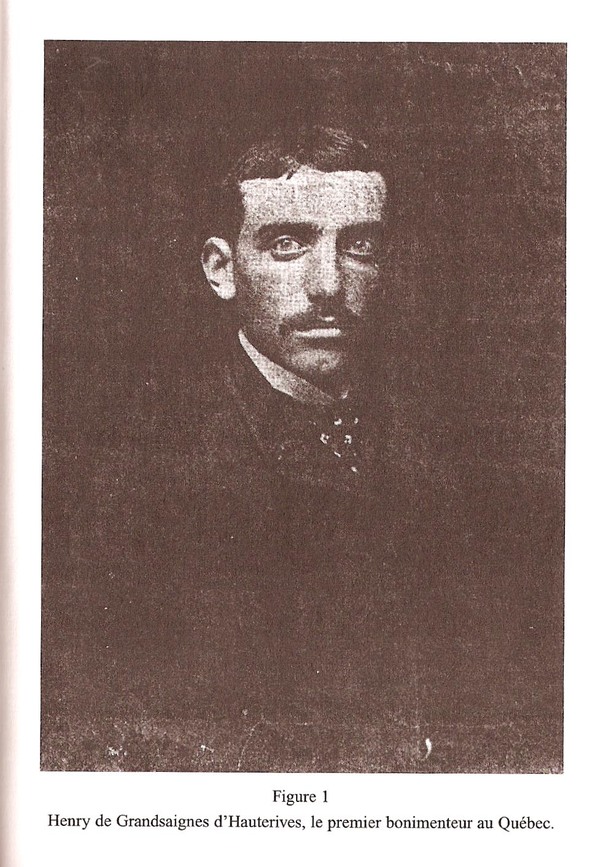
Source: Link
GRANDSAIGNES D’HAUTERIVES, HENRY DE, Vicomte de GRANDSAIGNES D’HAUTERIVES (named at birth Henri-Louis-Marie), itinerant projectionist and cinema operator; b. 28 July 1869 in Pont-l’Abbé, France, son of Gustave de Grandsaignes d’Hauterives, Comte de Grandsaignes d’Hauterives, a customs collector, and Marie Tréourret de Kerstrat; m. first in June 1894 Charlotte Subé in Paris, and they had one son, Robert, who was the treasurer of the North Atlantic Treaty Organization (NATO) in 1950; m. secondly in 1922 in the same city Marguerite Holleville; d. there 26 Sept. 1929.
Henry de Grandsaignes d’Hauterives belonged to two distinguished families of the French nobility. On his mother’s side he was a descendant of the Comte de Mirabeau, a writer and a great revolutionary leader; on his father’s side he had a prestigious military ancestry. These families had been impoverished by the French revolution and the advent of the Republic, but, through shrewd investments and creative management, Henry’s mother restored the family’s fortunes and prestige by setting up one of the first commercial holiday resorts in Brittany. Becoming a solicitor in Paris after he had studied law in Poitiers, Henry soon went into debt because of an extravagant style of living which caused his wife to leave him in 1897. He then decided to set out for North America, bent on making his fortune in the fledgling cinema business. To this end, he went into partnership with his mother, who became the manager of Historiographe Compagnie, an itinerant cinema company.
The Vicomte and Comtesse d’Hauterives, as they were known in Canada, began presenting films in Montreal in October 1897 and they were among the first to offer this kind of entertainment. After several profitable months, they began a tour of Quebec towns in 1898; they drew audiences on obtaining the prior consent of the civil and religious authorities. They next went to Ontario and in 1899 they continued along the eastern seaboard of the United States, visiting New York, Boston, Atlantic City, N.J., and the neighbouring towns. Their tours soon extended to Bermuda and Saint-Pierre and Miquelon.
Until 1906 the province of Quebec was the main area of activity for Grandsaignes d’Hauterives and his mother. They returned there every fall for tours in the course of which they showed dozens of films (then of only a few minutes’ duration) in theatres, schools, and parish halls. They used a projector called a Historiographe, which was operated by a crank that ran the film in front of a lens illuminated by a gas lamp. The shows were well known and praised for their high quality. They included the most recent French films, especially historical ones, purchased from Charles Pathé and Georges Méliès and coloured by hand in a Parisian workshop. Grandsaignes d’Hauterives was famous as a “bonimenteur,” the now obsolete occupation of providing an oral commentary on silent films. The journalists of the day almost unanimously praised his relevant and eloquent talks, which were given in both French and English during the shows.
However, the increase in the number of movie houses led Grandsaignes d’Hauterives and his mother to give up their tours. They ran movie houses in New York from 1906 to 1908, in St Louis, Mo., from 1908 to 1910, and in Bermuda and the islands of Saint-Pierre and Miquelon from 1910 to 1913. Their activities were eventually curtailed and then brought to an end by the monopolization of the American movie industry that forced operators to become part of networks with which neither the Vicomte nor his mother wished to be associated. They insisted on remaining independent and on operating their cinemas on a seasonal basis, but this approach did not fit commercial practices. After returning to France in 1913, without having made his fortune, Grandsaignes d’Hauterives worked as a civil servant in Rouen during the war and as a solicitor in Paris from 1920 until his death in 1929 (his mother had died in December 1920). During that period, he was better known for his worldly conviviality than for his professional activities.
A happy-go-lucky aristocrat who toiled as an obscure civil servant in France, Henry de Grandsaignes d’Hauterives had been a daring pioneer in the cinema industry in North America, travelling the continent to present a new type of show, which he popularized by enhancing the interest of early silent films with the excitement of fascinating oral narration. Throughout his years in North America he continued to offer French films to all kinds of audiences, maintaining his reputation as an outstanding cinema operator. Showing silent films with commentary, a practice he initiated in Quebec, lasted until 1930. Many people became acquainted with the cinema through his work.
This biography is based on contemporary newspaper accounts of Henry de Grandsaignes d’Hauterives’s shows and on the correspondence of the Comtesse Marie de Grandsaignes d’Hauterives in the Arch. Départementales of Finistère (Quimper, France), dossier 60 J 67.
Arch. Départementales, Finistère, État civil, Pont-l’Abbé, 28 juill. 1869. Arch. Municipales, Paris, État civil, 28 sept. 1929. Germain Lacasse et Serge Duigou, L’Historiographe (les débuts du spectacle cinématographique au Québec) (Montréal, 1985); Marie de Kerstrat, l’aristocrate du cinématographe (Quimper, 1987).
Cite This Article
Germain Lacasse, “GRANDSAIGNES D’HAUTERIVES, HENRY DE, Vicomte de GRANDSAIGNES D’HAUTERIVES (Henri-Louis-Marie),” in Dictionary of Canadian Biography, vol. 15, University of Toronto/Université Laval, 2003–, accessed January 1, 2026, https://www.biographi.ca/en/bio/grandsaignes_d_hauterives_henry_de_15E.html.
The citation above shows the format for footnotes and endnotes according to the Chicago manual of style (16th edition). Information to be used in other citation formats:
| Permalink: | https://www.biographi.ca/en/bio/grandsaignes_d_hauterives_henry_de_15E.html |
| Author of Article: | Germain Lacasse |
| Title of Article: | GRANDSAIGNES D’HAUTERIVES, HENRY DE, Vicomte de GRANDSAIGNES D’HAUTERIVES (Henri-Louis-Marie) |
| Publication Name: | Dictionary of Canadian Biography, vol. 15 |
| Publisher: | University of Toronto/Université Laval |
| Year of publication: | 2005 |
| Year of revision: | 2005 |
| Access Date: | January 1, 2026 |



